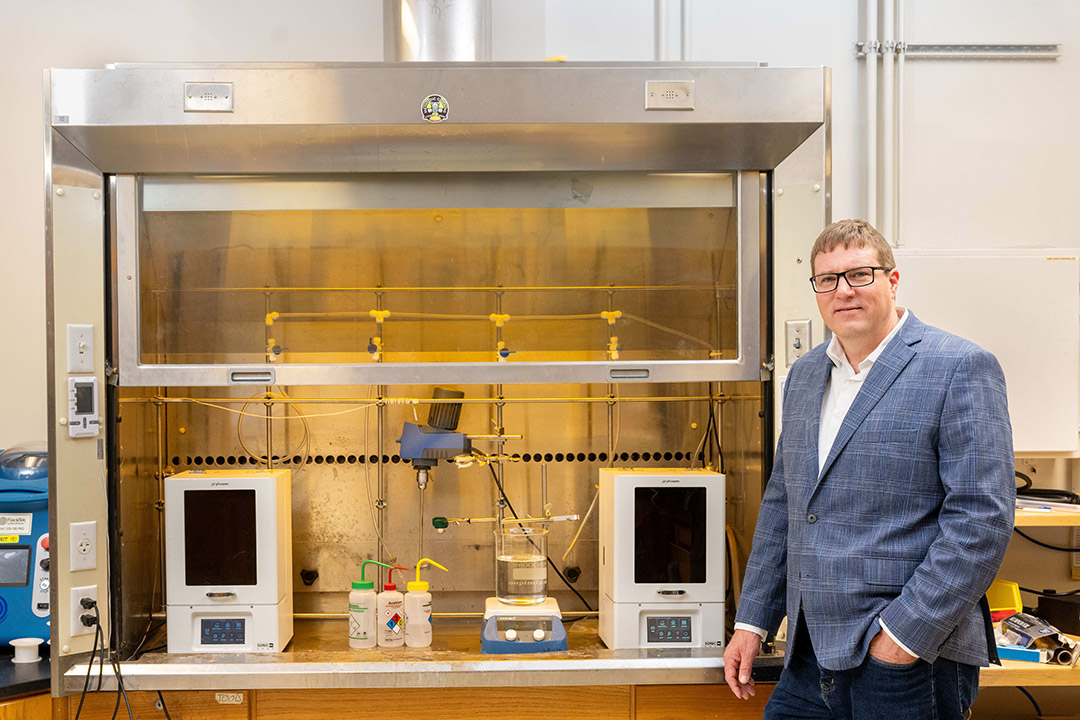 Researchers develop self-healing materials to improve 3D-printing processesSelf-healing materials are being developed by RIT researchers to further improve additive manufacturing, specifically 3D-printed products, to make them stronger and more resilient. Christopher Lewis and members of his research team developed a stimuli-responsive photopolymer solution—liquid resins similar in texture to superglue—that once printed exhibits the ability to self-heal when damaged, and through the lithography process, these liquid resins solidify selectively, layer-by-layer. There is a lot of interest today in materials that can heal, or self-repair, themselves. In 3D printing, the ability to build more reliable parts that have these healing actions can benefit multiple industries and provide cost savings. Companies can rely more confidently on the strength of materials being used for high-precision equipment such as printed electronics, soft robotics, or prosthetics for the aerospace, automotive, and biomedical fields, said Lewis, an associate professor and Russell C. McCarthy Endowed Professor in RIT’s College of Engineering Technology. “When you break a bone, or cut yourself, we take it for granted that there is a self-repairing mechanism that allows for bones or skin to rejuvenate themselves, at least to some extent,” said Lewis. “We also learn that it is not true for synthetic materials or man-made objects. And our work in self-healing materials is a futuristics look at how we can develop systems that mimic those natural material properties.” Peter Schuck/RIT Christopher Lewis, left, discussed the cellular nuances related to the self-healing resins with BS/MS student Kaia Ambrose. Ambrose is part of the team focused on shape memory behavior. Over time, 3D-printed objects can crack, particularly those used in load-bearing applications. This is worsened by the fact that many of the materials used in 3D printing are inherently brittle. Without intervention, the structures can fail. The team discovered that by combining a thermoplastic agent with an ultraviolet-curable resin enables a stronger 3D-printing process, while also creating a blend that reinforces cracked areas. “It makes the material much stronger than it used to be. One of the problems with these soft, elastomeric materials is that they are traditionally weak. And it also engenders another type of property—shape memory behavior, and we are just starting to focus our efforts on better understanding this behavior,” said Lewis. At the forefront of this work for several years, Lewis received funding from the U.S. Department of Defense and partnered with scientists in RIT’s AMPrint Center to test how self-healing materials supplement 3D-print processes. He and co-authors Vincent Mei and Kory Schimmelpfennig, RIT doctoral students, detailed the work in several journals including ACS Applied Polymer Materials, Polymer, and a recent issue of 3D Print Industry. Each highlights the team’s focus on the UV-vat polymerization of this liquid resin system. The challenges, he said, are in regulating the viscosity of the reactive resin, and ensuring all materials are soluble and light sensitive. “The approach we have taken is one where we have a mixture of two different things. We have our photoreactive, thermosetting polymer that once cured becomes a soft rubber. To this, we also add a thermoplastic healing agent. We were able to get light to pass through the system, and we achieved that by utilizing polymerization induced phase separation (PIPS). It is a process where the thermoset and thermoplastic materials separate during curing,” he said. “That is key to this whole thing.” PIPS is a single, segmented function where an optically transparent liquid allows light to pass through. By curing the UV resin, the thermoplastic phase separates. Lewis compared that final phase-separated structure to a lava lamp that changes as it is lit or heated. It is similar with the polymers that transform as they are integrated with the 3D-print as each layer is cured. “Earlier work on thermoplastic polymer blends that are able to be processed using conventional techniques like injection molding or extrusion suggested that it was that phase separation that seemed to be driving the self-healing behavior of those systems. That understanding led us down this path of experimentation with this same healing agent and photo reactive polymer system, and then, a little bit of luck,” said Lewis.
Researchers develop self-healing materials to improve 3D-printing processesSelf-healing materials are being developed by RIT researchers to further improve additive manufacturing, specifically 3D-printed products, to make them stronger and more resilient. Christopher Lewis and members of his research team developed a stimuli-responsive photopolymer solution—liquid resins similar in texture to superglue—that once printed exhibits the ability to self-heal when damaged, and through the lithography process, these liquid resins solidify selectively, layer-by-layer. There is a lot of interest today in materials that can heal, or self-repair, themselves. In 3D printing, the ability to build more reliable parts that have these healing actions can benefit multiple industries and provide cost savings. Companies can rely more confidently on the strength of materials being used for high-precision equipment such as printed electronics, soft robotics, or prosthetics for the aerospace, automotive, and biomedical fields, said Lewis, an associate professor and Russell C. McCarthy Endowed Professor in RIT’s College of Engineering Technology. “When you break a bone, or cut yourself, we take it for granted that there is a self-repairing mechanism that allows for bones or skin to rejuvenate themselves, at least to some extent,” said Lewis. “We also learn that it is not true for synthetic materials or man-made objects. And our work in self-healing materials is a futuristics look at how we can develop systems that mimic those natural material properties.” Peter Schuck/RIT Christopher Lewis, left, discussed the cellular nuances related to the self-healing resins with BS/MS student Kaia Ambrose. Ambrose is part of the team focused on shape memory behavior. Over time, 3D-printed objects can crack, particularly those used in load-bearing applications. This is worsened by the fact that many of the materials used in 3D printing are inherently brittle. Without intervention, the structures can fail. The team discovered that by combining a thermoplastic agent with an ultraviolet-curable resin enables a stronger 3D-printing process, while also creating a blend that reinforces cracked areas. “It makes the material much stronger than it used to be. One of the problems with these soft, elastomeric materials is that they are traditionally weak. And it also engenders another type of property—shape memory behavior, and we are just starting to focus our efforts on better understanding this behavior,” said Lewis. At the forefront of this work for several years, Lewis received funding from the U.S. Department of Defense and partnered with scientists in RIT’s AMPrint Center to test how self-healing materials supplement 3D-print processes. He and co-authors Vincent Mei and Kory Schimmelpfennig, RIT doctoral students, detailed the work in several journals including ACS Applied Polymer Materials, Polymer, and a recent issue of 3D Print Industry. Each highlights the team’s focus on the UV-vat polymerization of this liquid resin system. The challenges, he said, are in regulating the viscosity of the reactive resin, and ensuring all materials are soluble and light sensitive. “The approach we have taken is one where we have a mixture of two different things. We have our photoreactive, thermosetting polymer that once cured becomes a soft rubber. To this, we also add a thermoplastic healing agent. We were able to get light to pass through the system, and we achieved that by utilizing polymerization induced phase separation (PIPS). It is a process where the thermoset and thermoplastic materials separate during curing,” he said. “That is key to this whole thing.” PIPS is a single, segmented function where an optically transparent liquid allows light to pass through. By curing the UV resin, the thermoplastic phase separates. Lewis compared that final phase-separated structure to a lava lamp that changes as it is lit or heated. It is similar with the polymers that transform as they are integrated with the 3D-print as each layer is cured. “Earlier work on thermoplastic polymer blends that are able to be processed using conventional techniques like injection molding or extrusion suggested that it was that phase separation that seemed to be driving the self-healing behavior of those systems. That understanding led us down this path of experimentation with this same healing agent and photo reactive polymer system, and then, a little bit of luck,” said Lewis.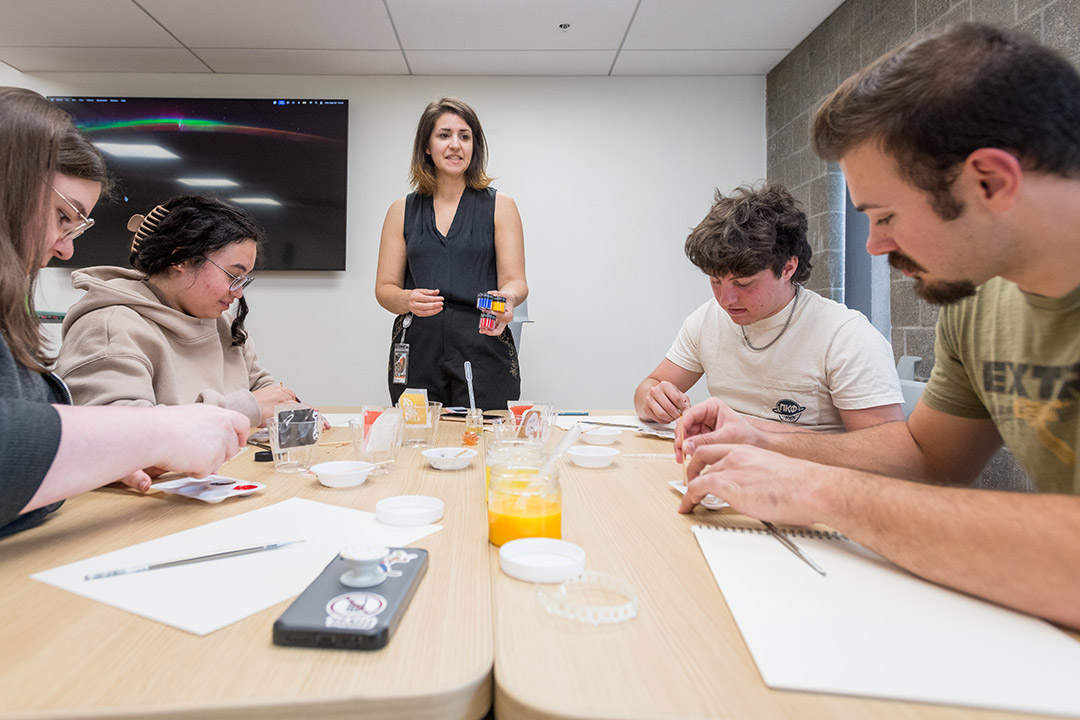 Ph.D. candidate encourages her class to judge a book by its coverAs a professional paper conservator and color science Ph.D. candidate, Leah Humenuck has studied books from every angle and wavelength. This semester, Humenuck is sharing her love for paper, ink, pigments, and all the material components of a book, in her course, The Secret Lives of Books, a special topics elective offered by the museum studies program in the College of Liberal Arts. She is gaining hands-on experience from the other side of the classroom, working with undergraduate students, sampling an academic career, and adding to her résumé. While the evolution of the book has been a global accomplishment, Humenuck focuses on book development in the Western world and the influence of parchment, which shaped the form, Gutenberg’s game-changing printing press, and the rise of paper. Her class teaches students how to assess a book through its materials and construction. Trends in book development point to available materials and choices often based in practicalities, she said. “There’s more than one way to read a book,” Humenuck said. She alternates her lectures with lab experiences that focus on handling rare books, mixing pigments, learning about book storage, and papermaking. “I think the best way to interact with history is to do the history,” Humenuck added. Christis Shepard, a fourth-year museum studies major from Bayonne, N.J., is enjoying the deep dive into the history of making books. “We’re currently learning about medieval books, the inks medieval scribes and artisans used, and the techniques used in creating parchment,” Shepard said. “It makes me appreciate the ease we have today in making books and that many of these old books managed to survive into the modern day.” Humenuck’s class meets in Wallace Library and frequently visits the Cary Graphic Arts Collection, RIT’s special collection of rare books, and graphic design and printing history. “I wanted to create a class that would intersect with the Cary Collection,” Humenuck said. “I tell my students, ‘While you’re here, use the Cary Collection because it’s phenomenal.’” Humenuck developed the special topics class at the suggestion of Juilee Decker, director of museum studies and co-director of the Cultural Heritage Imaging lab. Decker knew of Humenuck’s interest in an academic career. Liam Myerow A student in the Secret Lives of Books course creates pigments in a medieval method by combining the powdered pigment with a binder in the glass jar. “I enjoy tapping into what students are doing at the graduate level and seeing how they might inform what we’re doing in museum studies,” Decker said. “I thought that Leah’s expertise as a book and paper conservator would provide a materials perspective on a topic that is related to museum studies.” With a focus on libraries, archives, and museums, and a tech-infused approach to liberal arts and sciences, RIT’s museum studies program is one of the few undergraduate degree programs of its kind in the United States, Decker added. Interdisciplinary in nature, the program draws upon expertise from multiple colleges and divisions with a book niche. Steven Galbraith, curator of the Cary Graphic Arts Collection, teaches a course about the history of the book from a curatorial perspective, and faculty at the Image Permanence Institute offer a course about preservation and collections care. “Leah has served as a mentor and an internship supervisor for a number of my students,” Decker said. “I work with her in a research capacity, so I am aware of her excellent scholarship ethics and her keen eye toward mentoring and developing lifelong learning goals for people.” The path to becoming a college instructor is different for every Ph.D. student. The Secret Lives of Books is Humenuck’s first experience writing a syllabus and planning a curriculum for a semester-long class. Decker gave her guidance about classroom parameters and syllabi. She has also sat in on Humenuck’s classes. “It’s common that there’s not a precursor to teaching,” Decker said, reflecting on her doctoral degree at Case Western University. “There isn’t a formal class that says, ‘This is how you become an instructor now that you want to share your knowledge of this topic.’” The opportunity to teach builds upon Humenuck’s experience gained through her many guest lectures and talks, conference presentations, an internship program she created for museum studies, and her semester as a graduate teaching assistant for the Fundamentals of Color Science course. Christie Leone, assistant dean of the RIT Graduate School, said there are a lot of opportunities for graduate students to gain hands-on teaching experience by working as graduate teaching assistants under the supervision of a faculty mentor. Graduate teaching assistants are required to take a training course, GTA Foundations, offered by the Graduate School in collaboration with the Center for Teaching and Learning. The class provides basic background information and introduction to the responsibilities of a graduate teaching assistant at RIT. In addition, some colleges and departments offer their own training specific to their discipline. Humenuck’s class is giving her a multidisciplinary teaching experience. The elective has drawn 17 students from a variety of majors and with different opinions on materials for preserving information. “Being able to answer questions and pull a class together with students having different perspectives is something I really enjoy,” Humenuck said.
Ph.D. candidate encourages her class to judge a book by its coverAs a professional paper conservator and color science Ph.D. candidate, Leah Humenuck has studied books from every angle and wavelength. This semester, Humenuck is sharing her love for paper, ink, pigments, and all the material components of a book, in her course, The Secret Lives of Books, a special topics elective offered by the museum studies program in the College of Liberal Arts. She is gaining hands-on experience from the other side of the classroom, working with undergraduate students, sampling an academic career, and adding to her résumé. While the evolution of the book has been a global accomplishment, Humenuck focuses on book development in the Western world and the influence of parchment, which shaped the form, Gutenberg’s game-changing printing press, and the rise of paper. Her class teaches students how to assess a book through its materials and construction. Trends in book development point to available materials and choices often based in practicalities, she said. “There’s more than one way to read a book,” Humenuck said. She alternates her lectures with lab experiences that focus on handling rare books, mixing pigments, learning about book storage, and papermaking. “I think the best way to interact with history is to do the history,” Humenuck added. Christis Shepard, a fourth-year museum studies major from Bayonne, N.J., is enjoying the deep dive into the history of making books. “We’re currently learning about medieval books, the inks medieval scribes and artisans used, and the techniques used in creating parchment,” Shepard said. “It makes me appreciate the ease we have today in making books and that many of these old books managed to survive into the modern day.” Humenuck’s class meets in Wallace Library and frequently visits the Cary Graphic Arts Collection, RIT’s special collection of rare books, and graphic design and printing history. “I wanted to create a class that would intersect with the Cary Collection,” Humenuck said. “I tell my students, ‘While you’re here, use the Cary Collection because it’s phenomenal.’” Humenuck developed the special topics class at the suggestion of Juilee Decker, director of museum studies and co-director of the Cultural Heritage Imaging lab. Decker knew of Humenuck’s interest in an academic career. Liam Myerow A student in the Secret Lives of Books course creates pigments in a medieval method by combining the powdered pigment with a binder in the glass jar. “I enjoy tapping into what students are doing at the graduate level and seeing how they might inform what we’re doing in museum studies,” Decker said. “I thought that Leah’s expertise as a book and paper conservator would provide a materials perspective on a topic that is related to museum studies.” With a focus on libraries, archives, and museums, and a tech-infused approach to liberal arts and sciences, RIT’s museum studies program is one of the few undergraduate degree programs of its kind in the United States, Decker added. Interdisciplinary in nature, the program draws upon expertise from multiple colleges and divisions with a book niche. Steven Galbraith, curator of the Cary Graphic Arts Collection, teaches a course about the history of the book from a curatorial perspective, and faculty at the Image Permanence Institute offer a course about preservation and collections care. “Leah has served as a mentor and an internship supervisor for a number of my students,” Decker said. “I work with her in a research capacity, so I am aware of her excellent scholarship ethics and her keen eye toward mentoring and developing lifelong learning goals for people.” The path to becoming a college instructor is different for every Ph.D. student. The Secret Lives of Books is Humenuck’s first experience writing a syllabus and planning a curriculum for a semester-long class. Decker gave her guidance about classroom parameters and syllabi. She has also sat in on Humenuck’s classes. “It’s common that there’s not a precursor to teaching,” Decker said, reflecting on her doctoral degree at Case Western University. “There isn’t a formal class that says, ‘This is how you become an instructor now that you want to share your knowledge of this topic.’” The opportunity to teach builds upon Humenuck’s experience gained through her many guest lectures and talks, conference presentations, an internship program she created for museum studies, and her semester as a graduate teaching assistant for the Fundamentals of Color Science course. Christie Leone, assistant dean of the RIT Graduate School, said there are a lot of opportunities for graduate students to gain hands-on teaching experience by working as graduate teaching assistants under the supervision of a faculty mentor. Graduate teaching assistants are required to take a training course, GTA Foundations, offered by the Graduate School in collaboration with the Center for Teaching and Learning. The class provides basic background information and introduction to the responsibilities of a graduate teaching assistant at RIT. In addition, some colleges and departments offer their own training specific to their discipline. Humenuck’s class is giving her a multidisciplinary teaching experience. The elective has drawn 17 students from a variety of majors and with different opinions on materials for preserving information. “Being able to answer questions and pull a class together with students having different perspectives is something I really enjoy,” Humenuck said.
- RIT Ambulance expands its fleet with a second rigRochester Institute of Technology, which has had its own emergency medical service for more than 50 years, now has a new, second ambulance available to help students, employees, visitors, even nearby community members in need. Nearly 60 people, about half of them current students, work at RIT Ambulance (RITA) and respond to more than 600 calls a year, ranging from general sickness or traumatic injuries. The ambulance is on standby at sporting events and major gatherings on campus. They also can respond to nearby accidents, fires, or other emergencies off campus if needed. Their calls have been increasing each year since 2021, and there is no charge to the patients. “Sometimes there’s a misconception that we’re just a club,” said Riley Howard, RITA’s vice president and a fourth-year physician assistant major from Allison Park, Pa., who joined RITA three years ago. “Some think because we’re college students, we may be inexperienced. But we receive the same training as all licensed ambulance services.” Some of the RITA members are alumni, and some work or volunteer for outside agencies as paramedics, EMTs and drivers. Dr. Lindsay Phillips, physician/medical director for the Student Health Center, said RITA members inspire her with their commitment to RIT. “They’re responding to injuries and distress across campus nearly every day, even as they juggle responsibilities of academics, work, and social commitments,” she said. “Faculty, staff, students, and visitors all get the same level of attention and professionalism whether it’s a call for chest pain, a sprained ankle playing basketball, or a lab accident.” Phillips said she’s realized over the years the amount of preparation needed to be ready for the variety of responses. Members take rigorous, mentored training as either medics or ambulance drivers, and the duty roster requires thought and pairing of experienced trainers with learners. RITA not only provides valuable medical service, it also provides leadership development opportunities for its volunteers. Large campus events also require coordination and planning with other emergency services. Traci Westcott/RIT New York State Senator Jeremy Cooney helped secure a $272,000 state grant for the new ambulance. “RITA leadership is always planning curriculum, coaching new members through their training, organizing schedules, and creating opportunities for connection with the membership,” Phillips said. “The camaraderie in the corps is amazing.” The new ambulance was made possible with a $272,000 state grant from State Senator Jeremy Cooney that RITA members help craft and submit in 2024. “RIT Ambulance is renowned for their expertise in providing real world medical experience to students and in keeping the entire campus community safe and cared for,” Cooney said. “Our students can only succeed if they feel safe, and that’s exactly why I was proud to deliver state funding for RIT’s second ambulance, a needed step that allows them to continue to serve as a model for what on-campus emergency medical services should look like.” Since 2018, RITA has been recognized by the National Collegiate Emergency Medical Services Foundation as an EMS Ready Campus for its excellence in emergency management and disaster preparedness. The second ambulance, which joins the existing one built in 2013, will enable RITA to respond to service calls even when one ambulance and crew are engaged in an on-campus event. It will also eliminate disruption in case one ambulance needs maintenance or repair. RITA also has a “fly car” that can respond to calls if an additional person is needed, but that vehicle doesn’t transport patients. RITA recruits new members each fall, seeking people willing to spend time to be trained and be available for regular shifts. Normally two people are assigned to shifts, and others will respond if they hear a call and are nearby to help. Visit the RITA website if you would like to possibly join.
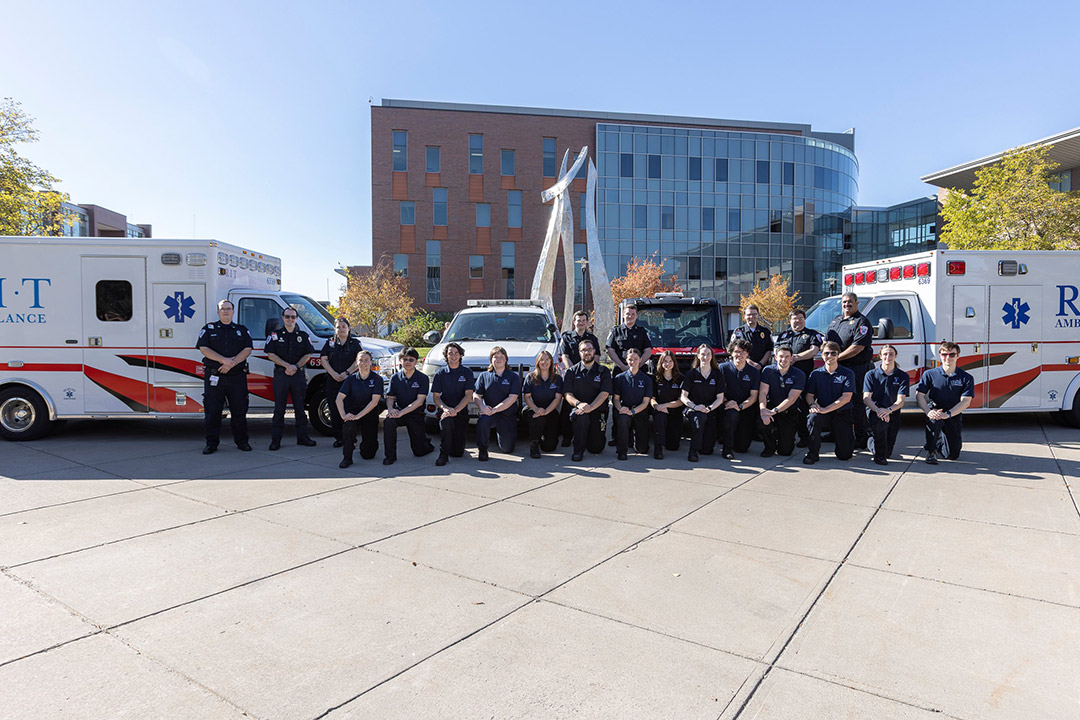
- Tait Preserve garden yields produce for campus eateriesStudents dining at Gracie’s and Brick City Café might not know it, but some of the vegetables they’re eating may have been harvested that very same day on RIT property. In its fourth year of production with a “farm to table” spirit, a 120-foot by 60-foot garden at the university’s Tait Preserve in Penfield, N.Y., yields about 3,000 pounds of vegetables and herbs per year, used for healthy meals in dining areas and at special events served by RIT Catering. The raised-bed garden was designed to accommodate high density and high production to provide fresh produce to RIT. It yields green beans, Swiss chard, green onions, spinach, tomatoes, squash, kale, cherry tomatoes, culinary pumpkins, beets, eggplant, cilantro, fingerling potatoes, three types of peppers, and a variety of herbs. Carlos Ortiz/RIT Meghan Gilbert, senior gardens and grounds specialist at RIT’s Tait Preserve, harvests beets to be used at Gracie’s and RIT Catering. “Sometimes RIT Dining has had a hard time sourcing specialty ingredients such as habaneros and scotch bonnet peppers on a consistent basis,” said Meghan Gilbert, the preserve’s senior gardens and grounds specialist. Some of those ingredients are necessary for Jamaican and Haitian dishes, which have been added as occasional dining options to accommodate requests from students. “We’re able to fill a niche by growing items they cannot source elsewhere,” she said. The preserve is a former quarry site, with very sandy soil not suited for vegetable growing. So, the garden beds are raised 30 inches off the ground, with topsoil and compost used to sustain the plants. “We space plants closely for high-volume output,” Gilbert said. “We try to provide RIT Dining with as much fresh produce as possible during our growing season.” Harvesting can be done as late as December, especially for kale and other cold-hardy crops, she said. Student employees pick the mature vegetables and herbs and place them in produce bins for delivery to RIT. Carlos Ortiz/RIT A hydroponic system at Tait Preserve is being used to grow watercress for use at Gracie’s and RIT Catering as ingredients, in salad bars, side dishes, or as garnishes. “Having this garden provides a huge advantage in the quality and freshness of the produce,” Gilbert says. “The shelf life, taste, and nutritional value is much better when you can serve it quickly after the harvest, in our case, sometimes as soon as the same day. You’re not getting that from any other supplier. It’s hyper local. It’s literally grown 15 minutes away from campus and delivered with an electric car.” In addition to the garden, the grounds also feature an orchard with about 600 trees of 11 different apple varieties that were planted in 2022 and could be ready with a viable crop next year. Most will be used for eating, and some will be used for baking or garnishing. Gilbert meets with the staff from RIT Dining every winter to see if there’s anything new they’d like her to try to grow. She’s already experimenting with microgreens and is using a hydroponic system to grow watercress, which she said was deemed the most nutrient-dense vegetable by the Centers for Disease Control. RIT has set a goal to serve more plant-based food. Gilbert said culinary mushrooms could help with that effort, with future production plans in the works. “It’s a great little niche for us to try to figure out how we can play a part in this goal,” she said.
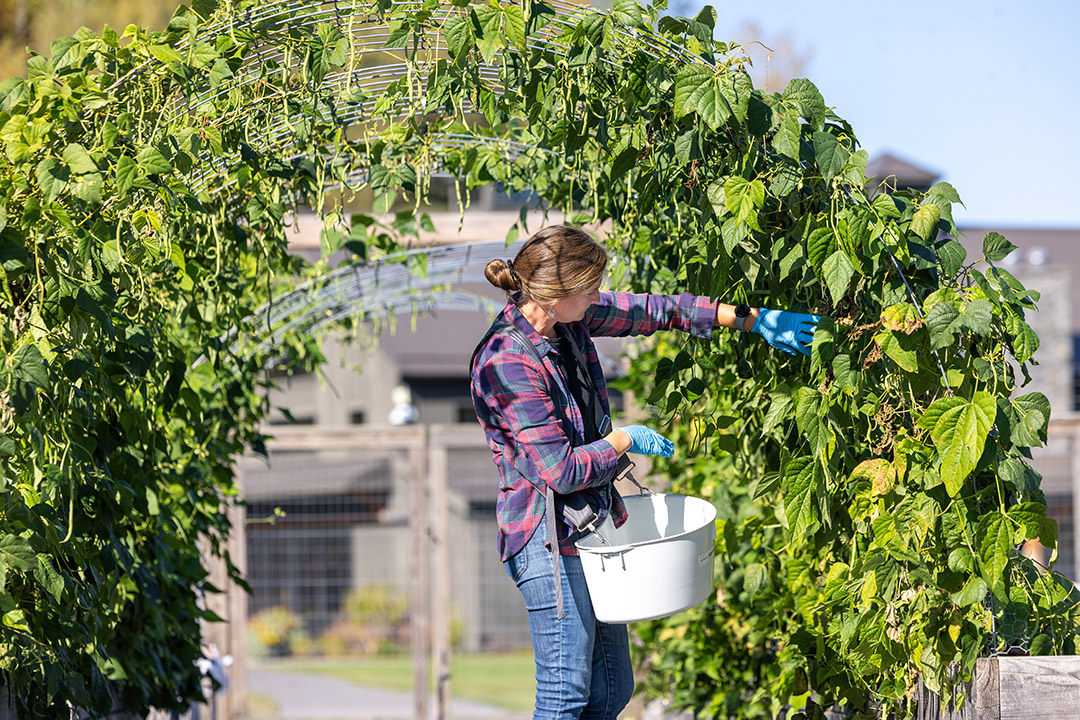
- RIT Big Shot team blitzes Highmark StadiumRochester Institute of Technology commemorated the Buffalo Bills’ final season at Highmark Stadium on Oct. 11 with a one-of-a-kind photograph that will be displayed in the new stadium when it opens next year. The 360-degree, extended exposure nighttime photo was created during the 37th RIT Big Shot, an annual event that has highlighted Croatia’s medieval Old Town in Dubrovnik, Cowboys Stadium, Churchill Downs, The Alamo, and dozens of locations in the United States. The project began in 1987 to teach RIT students how to solve complicated problems with simple tools and teamwork. On Oct. 11, thousands of students and community volunteers used flashlights and other light sources to “paint” the 52-year-old stadium with light, while the Big Shot camera team captured the image. Big Shot team This year’s Big Shot marked the first year the team created a full 360-degree panoramic image of a subject. The above image will be displayed in the new stadium when it opens next year. Eric Kunsman, co-coordinator of the Big Shot and assistant professor at RIT’s National Technical Institute for the Deaf, said the support from the regional community made this one of the biggest Big Shot events in recent years. “Whether people came out because they love photography, the Bills, or both, the fact that we had thousands of people working together to create one photo is a powerful experience,” he said. “When people see the photo online or in the new stadium, they can point to where they stood or where they pointed their flashlight to help create the image. It’s an incredible memory for everyone involved.” This year marked the first time that the Big Shot team captured a full 360-degree panoramic image of a subject. In addition to the panoramic photograph, the team captured six additional photographs to ensure every inch of the stadium was documented. Rebecca Villagracia, a fourth-year photojournalism student from Orange County, Calif., has set her sights on a career in professional sports photography after graduation. Participating in the Big Shot was both a fun way to contribute to Buffalo Bills’ history and a learning opportunity. Big Shot team Over 6,000 volunteers came out to help create the Big Shot photograph this year. Each “brushstroke” of light in the image above was created by Big Shot volunteers. Villagracia operated one of the six additional cameras placed at the top of the stadium, along with one of the Buffalo Bills’ photography interns. “This was kind of a once-in-a-lifetime type of opportunity,” she said. “I’ve photographed in baseball and basketball stadiums, but a football stadium is so much larger. I also don’t do a lot of nighttime photography where you’re just keeping the camera shutter open for a minute or two, so incorporating that into an aspect of sports photography with the unique venue was definitely something cool to learn.” Dan Hughes, Big Shot co-coordinator and lecturer in the School of Photographic Arts and Sciences in RIT’s College of Art and Design, said creating opportunities like this for students and the RIT photography community is always top-of-mind. “There is no better way to learn than by working alongside someone in the same position that a student might aspire to be in after they graduate,” said Hughes. “We’re grateful that the Buffalo Bills photography team helped make this possible for them.” Big Shot No. 37 was made possible by partnering with the Buffalo Bills and CEPA Gallery. The event is sponsored and organized by the School of Photographic Arts and Sciences in RIT’s College of Art and Design, NTID’s Department of Visual Communication Studies, Nikon, and the Estate of Henry D. Navas ’74 (MBA), ’77 MS (accounting) and Deborah L. Robbins. Other sponsors include Mccrae Industries, Hill + Valley Creative, and Scott’s Rochester Photo Supply. The final panoramic photograph will be available to purchase on the Big Shot website after Oct. 20. All six additional images will be posted to the website in the coming days. To keep up with the Big Shot community, go to the Big Shot Facebook page.

- Caroline Solomon installed as first woman president of RIT’s National Technical Institute for the DeafRethinking how to support students, leading and driving innovation, and investing in transformative teaching and impactful research are some of the focus areas of Caroline Solomon, who was installed as the first woman president of RIT’s National Technical Institute for the Deaf on Oct. 10. In her inauguration speech, Solomon, who also serves as vice president of RIT, encouraged the campus community to help “prepare students for a world that needs their voices, their leadership, their moral compasses, their ability to be agile and adapt and innovate.” Reflecting on her career and her path to leadership, Solomon talked about what her appointment means to the community. “It’s about every student who wonders if they can lead in spaces where they have never seen themselves reflected,” she said. “Your voice—whether it’s signed, spoken, written, or felt—matters deeply. Your perspective is needed. And your future is limitless.” Matthew Sluka/RIT Caroline Solomon is joined by past leaders of RIT’s National Technical Institute for the Deaf, from left to right, T. Alan Hurwitz, Robert Davila, and Gerry Buckley. Speakers included Bill Sanders, RIT president; Susan Holliday, vice chair, RIT Board of Trustees; Prabu David, RIT provost and senior vice president for Academic Affairs; Larry Buckley, senior associate dean, College of Science; Patricia Glibert, professor at the University of Maryland Center for Environmental Science’s Horn Point Laboratory; and Emma Kane, a fourth-year public policy and business administration student at RIT. “Dr. Solomon’s focus on research and teaching the STEM disciplines and her dedication to sharing her enthusiasm and excitement for the sciences with her students are what drives her and has made her such a success in classrooms, labs, on research vessels, and in remote regions throughout the world,” said Sanders. “I couldn’t be more thrilled to welcome you to RIT and to support you in your leadership of NTID.” The keynote address was delivered by Carol Padden, the Sanford I. Berman Endowed Chair, Distinguished Professor, and dean of the School of Social Sciences at the University of California San Diego. Padden, one of Solomon’s early mentors, talked about first impressions and what it takes to lead an institution like NTID. “I had the distinct impression that you were a person of quality and integrity,” said Padden of Solomon. “You’ve charted a solid path forward from these early years to this crowning achievement. The admiration comes from how much we identify with you, as a woman, as a deaf woman, a scientist, and a humane leader, all in one. Our country needs committed leaders who will work alongside others to plan a future for our universities in this crucial time in American history.” Solomon, who began her tenure at NTID on Aug. 18, joined the faculty of Gallaudet University as a biology instructor in 2000 and rose to the rank of professor in 2011. She received Gallaudet’s Distinguished Faculty Award in 2013 and was recognized by the Association for the Sciences of Limnology and Oceanography with its Ramon Margalef Award for Excellence in Education in 2017. She was appointed the dean of faculty in 2024. A renowned scientist and researcher, Solomon has devoted herself to encouraging and nurturing deaf and hard-of-hearing students in STEM fields and has presented on her research at national and international conferences. She is also a past participant in the Deaflympics as a swimmer and was inducted into the Deaflympics Hall of Fame in 2020. During her inauguration speech, Solomon also looked to the future of NTID. “NTID must be more that a place where knowledge is transferred,” she added. “It must be a space where students grow as a whole person and learn to embrace civil discourse. We will deepen our partnerships beyond the walls of this campus because our impact must extend into our communities, both here and around the world.”
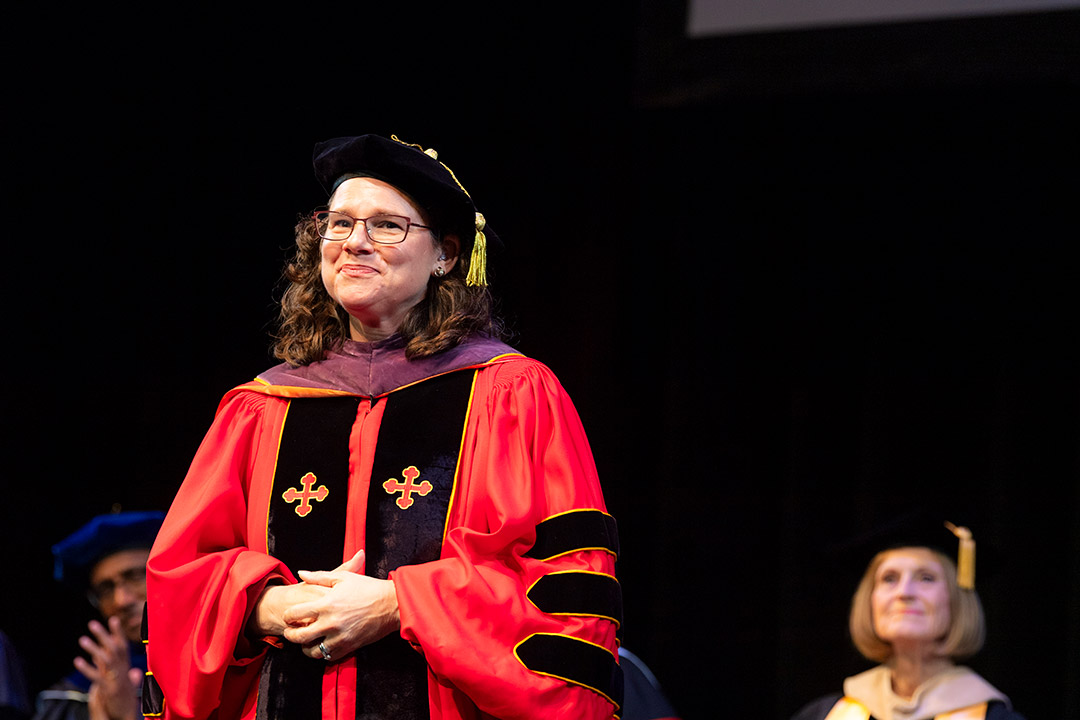
- RIT hosting international Fulbright Program studentsRIT’s main campus has welcomed six international Fulbright Program students for the 2025-2026 academic year. The Fulbright Program is a highly competitive international academic exchange program that aims to increase mutual understanding and to support friendly and peaceful relations between the people of the United States and other countries. More than 160 nations worldwide are involved in the program. The students noted the many areas of professional and personal development that the program provides, including networking, language skills, leadership, and adaptability. Esi Dervishi already has a master’s degree in business administration and experience working in human resources in her home country of Albania, but wants to expand her business acumen into more areas.She is majoring in hospitality business management at RIT. Dervishi appreciates the opportunity to learn from RIT professors who have expertise in the industry and the hands-on approach that RIT provides. “I’m not a big fan of just theory, so I appreciate the more practical approach to things,” said Dervishi. “The professors share their real-life experiences with us, making the lectures more insightful and engaging.” Outside of academics, the scholars have enjoyed joining groups and activities to become fully immersed in the campus community, and having the chance to explore the area. Fernando Diaz, a business administration master’s student from Panama, appreciates engaging with fellow students outside of the classroom. “Other than studying, there are a lot of activities,” said Diaz. “That’s what I love, the amount of clubs offered here. It doesn’t matter how niche your hobbies are, you can find a club or a group of people that have the same interests as you.” The Fulbright Program requires a rigorous application process. Diaz remarked that Panama had only two placements available for around 125 applicants. As one of the most prestigious scholarship programs in the world, numerous former scholars have gone on to become MacArthur fellows, Pulitzer Prize winners, and Nobel Prize winners. Diaz became familiar with the program through his professors at his university in Panama and learned more about it during an exchange program in New York four years ago. His goal then was to earn a Fulbright scholarship once he finished his undergraduate degree. Achieving that goal has been everything he hoped it would be. “Academically, socially, culturally, it has been amazing so far,” he said. “It’s very competitive, but that just reflects the quality of people you find in the program.” Diana Semionel joins RIT from Moldova and is pursuing a master’s in business administration. Her path to becoming a Fulbright scholar was a little different. As a non-traditional student, she already had professional experience but knew getting a scholarship for an advanced degree in the U.S. would be an amazing benefit. While initially it wasn’t the easiest to adapt, she said the people around her and the resources available at the university helped her persevere. Semionel is very grateful for the opportunity and hopes her experience can inspire others. “I feel like I’m finally one step closer to my dream,” she said. “I want to emphasize that anything is possible. It doesn't matter what age you are, where you are from, what your family situation is, who you are. Pursue your things and get the best from life.”
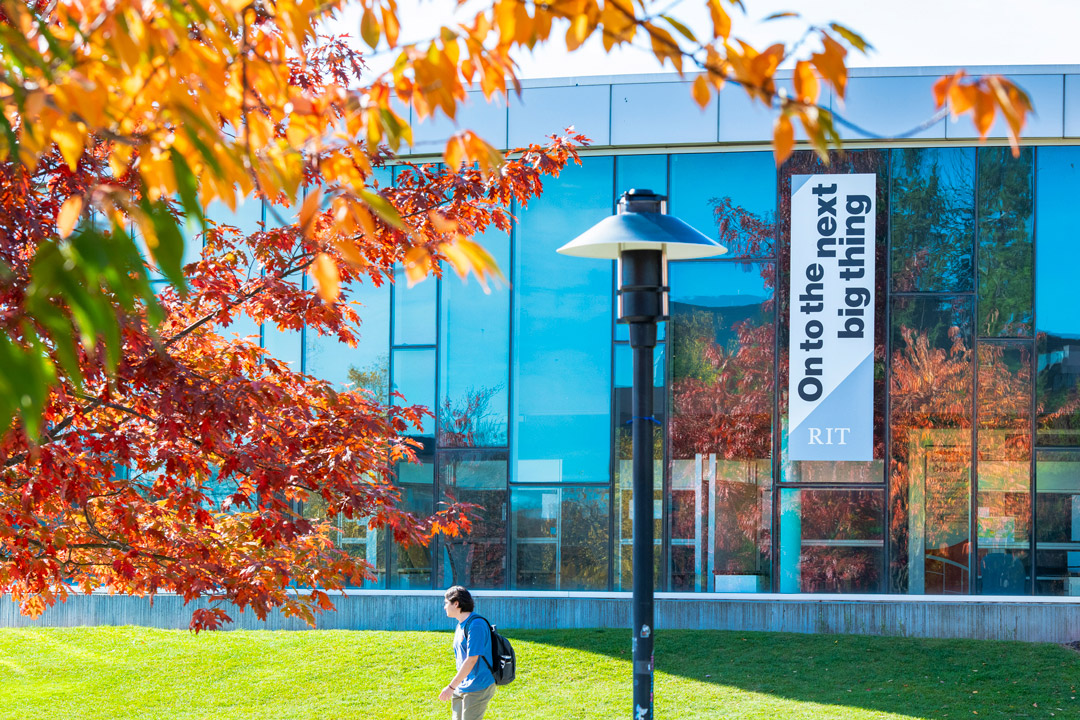
- Career fair connects students with companiesAs soon as the doors opened at the University-wide Career Fair, student Cassidy Ryan hustled her way to the booth occupied by National Grid. Not only was she excited to connect with alumna and fellow sorority sister Erika Sullivan, who returned to campus to recruit student talent, Ryan was also hoping to score an interview for a co-op with the company. “I’m nervous, but I’m looking forward to showing people who I am and what I’m capable of,” said Ryan, a second-year industrial and systems engineering major from Carmel, N.Y. Traci Westcott/RIT Dylan Lewis, a fourth-year mechanical engineering technology major from New Milford, Conn., left, speaks with Aaron Turner, head of systems engineering at ARKA, regarding available spring co-ops at the company. Ryan joined thousands of other RIT students searching for co-ops and full-time employment at more than 230 local, regional, and national companies represented at the career fair on Oct. 8. Sullivan ’24 (electrical engineering technology), an associate engineer in distribution, planning, and asset management for National Grid, was one of 250 alumni recruiters. Sullivan is part of the planning team responsible for the current and future power grid—a role she takes seriously because she’s “doing something good for the world.” “What I do really matters, and that’s so important to me,” she said. “The top-notch education that I received at RIT, along with the leadership skills that I gained through my involvement in Greek life, have helped give me the job and life that I have.” Maria Richart, director of RIT’s Career Services and Cooperative Education, is pleased to see the return of companies that have been noticeably absent in recent years due to economic concerns, as well as others that are looking for the kind of specific talent that RIT can provide. “I’m seeing that today’s tech companies are recruiting students with expertise in supply chain management and distribution, along with the more traditional technology positions,” said Richart. “RIT is training our students to be marketable and to be able to pivot where they’re most needed. Companies know they can find what they need here.” Traci Westcott/RIT Alexandria Young, a second-year software engineering student, right, interviews with Abby Plotzke, a manager at IBM. Alexandria Young, a second-year software engineering student from Westchester County, N.Y., is looking for a co-op in software development where she can use her skills in full-stack development. Her coursework in computing languages like Python, C++, and Java have prepared her for the job search, she said. Outside of the classroom, Young builds software focusing on memory management. “I would love to work for IBM but, if that doesn’t work out, I’ll continue looking for other experiential learning opportunities that will help build my portfolio.” New this year, Career Services and Cooperative Education recognized five companies for their outstanding work with RIT students. General Dynamics Mission Systems, D3 Embedded, Disney, Lockheed Martin, and Honeywell were cited for arranging mock interviews with students, meeting with clubs and organizations, and hiring students from a variety of majors. Alumnus Paul Wisotzke ’88 (business management), a senior engineering program manager with Honeywell, comes to campus weekly to coordinate career preparation seminars and sponsor hackathons and academic projects. Traci Westcott/RIT More than 230 companies, including Honda, Penske, Texas Instruments, Bausch and Lomb, GE Aerospace, and Wegmans, sent representatives to recruit top talent at RIT’s University-wide Career Fair on Oct. 8. “The students recognize that we are here to support them and to help them succeed,” he said. “We’re demonstrating the behaviors that are important in the workplace and are finding that students are clamoring to join our company because of that. We keep hiring RIT students because they are often the top talent.” RIT, which is No. 88 nationally in the 2026 U.S. News & World Report best colleges ranking, is also ranked No. 5 in the nation for co-ops and internships, exposing college students to new academic experiences outside the classroom.
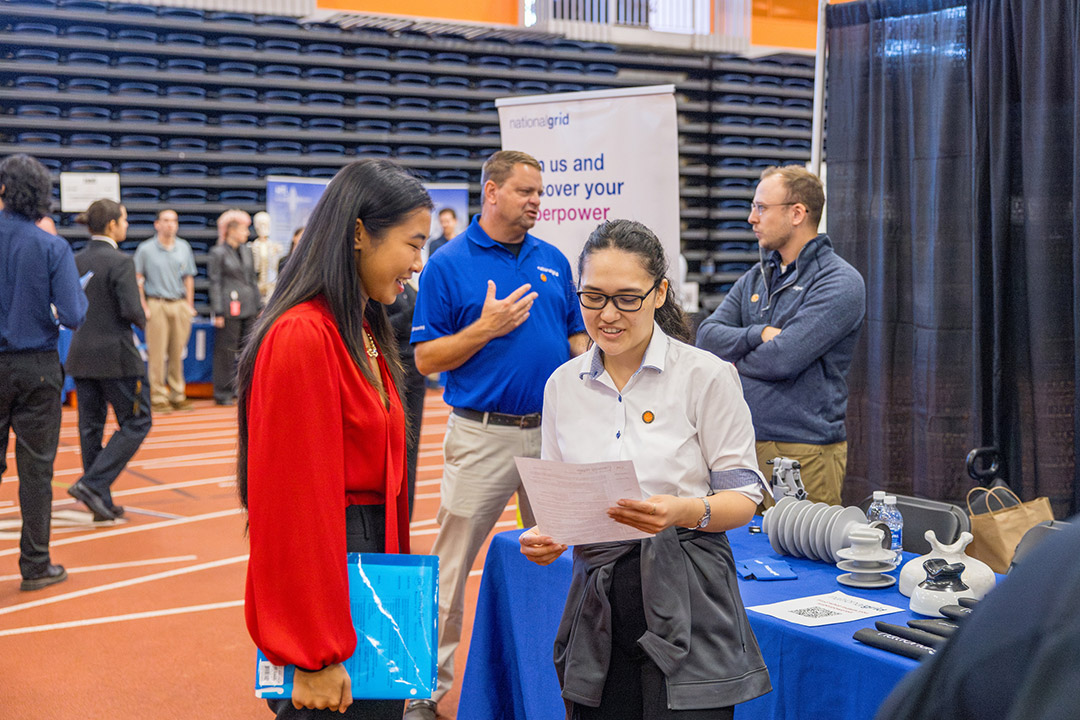
- Brick City Weekend gears up for thousands of visitorsThousands of students, alumni, their families, and others have already registered to attend at least one of dozens of events Oct. 17-19 during Brick City Homecoming and Family Weekend. Some events, such as the popular New York Dueling Pianos and Mt. Hope Cemetery historical tours, have reached capacity. But others, such as the Build-A-Tiger workshop, have added supplies to accommodate more participants due to higher-than-expected demand. Tickets are available for most events, including Emmy-winning animation veteran Dan Povenmire, co-creator and executive producer of Disney’s Phineas and Ferb, who will be this year’s Student Government speaker. He provides the voice of the evil Dr. Heinz Doofenshmirtz on the animated series and has amassed more than 7 million followers on Tik Tok and Instagram. He is also creator and executive producer of Disney’s original animated superhero series Hamster & Gretel. Provided Dan Povenmire, left, co-creator and executive producer of Phineas and Ferb, is this year’s Student Government speaker Oct. 18 during Brick City Homecoming and Family Weekend. Comic Craig Robinson, from ‘The Office,’ takes the stage on Oct. 17. With more than 25 years of experience in directing, storyboarding and writing, Povenmire has worked on multiple critically acclaimed animated series including Family Guy, SpongeBob SquarePants, The Simpsons, Rocko's Modern Life, and Hey Arnold! His talk is scheduled for the afternoon of Oct. 18 in the Gordon Field House and Activities Center. Comedian, actor, and musician Craig Robinson is scheduled for Oct. 17 in the Gordon Field House. Currently executive producer and star of Peacock’s Killing It, he’s best known for his portrayal of Darryl Philbin in The Office. Men’s hockey vs. Clarkson University is scheduled Oct. 18 at Blue Cross Arena, and two free women’s hockey games vs. St. Lawrence University are planned in the Gene Polisseni Center. A new clear bag, no backpack policy is now in force to enter the Polisseni Center during hockey games. “From comedian Craig Robinson to Emmy-winner Dan Povenmire, hockey, and family-friendly events, this year’s Brick City Weekend offers something for everyone,” said Lisa Stein, executive director for events and conferences at RIT. “It’s a fun and vibrant celebration that brings together the entire RIT community of alumni, students, faculty, staff, and families alike.” On Friday, visitors are invited to the University Gallery’s Vignelli Center for a conversation and gallery tour with artist Keisha Scarville, ’98, and student curator Chinenye Ozowalu, a fourth-year photographic and imaging arts major, into the making of Call and Response, a photo exhibit that explores memory, identity, and transformation through the layers of body, time, and landscape. The exhibit is on view through May 2026 in the RIT Photo Alum Gallery on the first floor of Wallace Library. Golden Circle events are planned, including a light breakfast, a tour of the SHED, VIP parking, and golf cart shuttles, for returning alumni from 1975 or earlier. Visitors are urged to sign up for text alerts for important announcements that may be issued that weekend. Text “BrickCity” to 888777 to receive updates. Reservations and tickets for all events are available from the Brick City website.

- RIT alumni turn shared experiences into growing outdoor brandFour RIT alumni and former student-athletes have turned locker-room bonds and an entrepreneurial drive into a growing company. Their venture, MULUS, began with a simple question: what if a bag could be tough enough for athletic pursuits, yet versatile enough for daily life? For founder Christopher Cherami ’11 (graphic design), the idea was struck during a family trip to the Jersey Shore. His sisters-in-law each carried a different style of bag—one a stiff rubber tote, the other a soft neoprene backpack. “I wouldn’t use either,” he recalled, “but if those two were combined, I knew I would.” After weeks of agonizing, his wife urged him to stop talking and start building, and before long Cherami was sketching prototypes and collaborating with fellow RIT lacrosse alumnus A.J. Tingle ’12 (industrial design) to shape the first MULUS model. Provided MULUS co-founders, from left, Christopher Cherami, Colin Jesien, and Jerry Ragonese during a jiu-jitsu training session, jokingly called their “karate weekends.” The venture quickly became a team effort as Cherami, a former men’s lacrosse player at RIT, brought in three Tigers alumni: fellow lacrosse alumni COO Colin Jesien ’06 (packaging science) and CMO Jerry Ragonese ’10 (photographic and imaging arts), as well as former RIT wrestler CFO Zach Greenberg ’06 (finance). Their approach to running MULUS is based on honest feedback and the trust that each teammate will carry their share of the load. “We’re always talking,” Greenberg said. “It might be a late-night group chat or a quick call between work meetings, but we’re constantly bouncing ideas around.” Their bond extends well beyond the company. The four still make time for traditions that grew out of their athletic roots, like their tongue-in-cheek “karate weekends,” when they meet up for jiu-jitsu training. Jesien likes to joke about how much fun it is to tell people he has a “karate weekend” planned, even if the workout is grueling. They also find ways to weave family and friendship together, whether it was through alumni lacrosse games, spontaneous road trips, or dinners with spouses and kids. Greenberg and Jesien are close, as Greenberg married into Jesien’s extended family. Behind the fun is serious progress. Each founder splits time between full-time careers and building MULUS. Greenberg is a product manager at Bloomberg, Jesien is the Director of Continuous Improvement at DYMA Brands, Ragonese wrapped up a successful professional lacrosse career and is the co-founder of the Face Off Academy and Pro Athletics, where Cherami spent over 13 years as a director and graphic designer. Cherami also works in franchising expansion and development for a private firm. The MULUS bag combines the structure of a rugged tote with the flexibility of a soft backpack, designed to carry everything from athletic gear to cameras and everyday essentials. Greenberg highlighted what makes the bag unique, noting that the design gives him confidence whether he’s carrying jiu-jitsu gear, hiking equipment, or camera gear worth thousands of dollars. “It’s different enough that it could be something people notice,” Greenberg said. “The style and components set it apart from other backpacks on the market.” Ragonese also described the brand’s personality in more playful terms. “The bag is that charismatic friend you can’t quite pin down,” he said. “One day he’s sailing in the Amalfi Coast, the next he’s at a networking event shaking hands and making everyone feel like they’ve known him for years. It’s just as useful for an athlete carrying gear as it is for a parent juggling diapers, snacks, and a good book.” Early runs of the bag were produced overseas, requiring careful planning around shipping costs and delivery schedules. Their collective goal was to build a durable product but keep it affordable for the market they wanted to reach. The unpredictability of that supply chain showed itself right away. One of the company’s earliest shipments was delayed for weeks after a major bridge accident in Baltimore shut down a critical shipping lane. The founders joke about it now, but at the time it was a true lesson of patience and perseverance. “We had this whole plan mapped out, and then suddenly everything was sitting on the water,” Jesien said. “It was a crash course in how little control you really have once a product leaves your hands.” MULUS gained traction last summer with a mention in Esquire and has continued to build word-of-mouth among athletes and outdoor enthusiasts. Cherami said the team is exploring new designs beyond the original backpack, from fanny packs and weekenders to outdoor gear such as beach chairs, shoes, and sunglasses. For the founders, the goal is creating a brand with staying power amongst a crowded market.
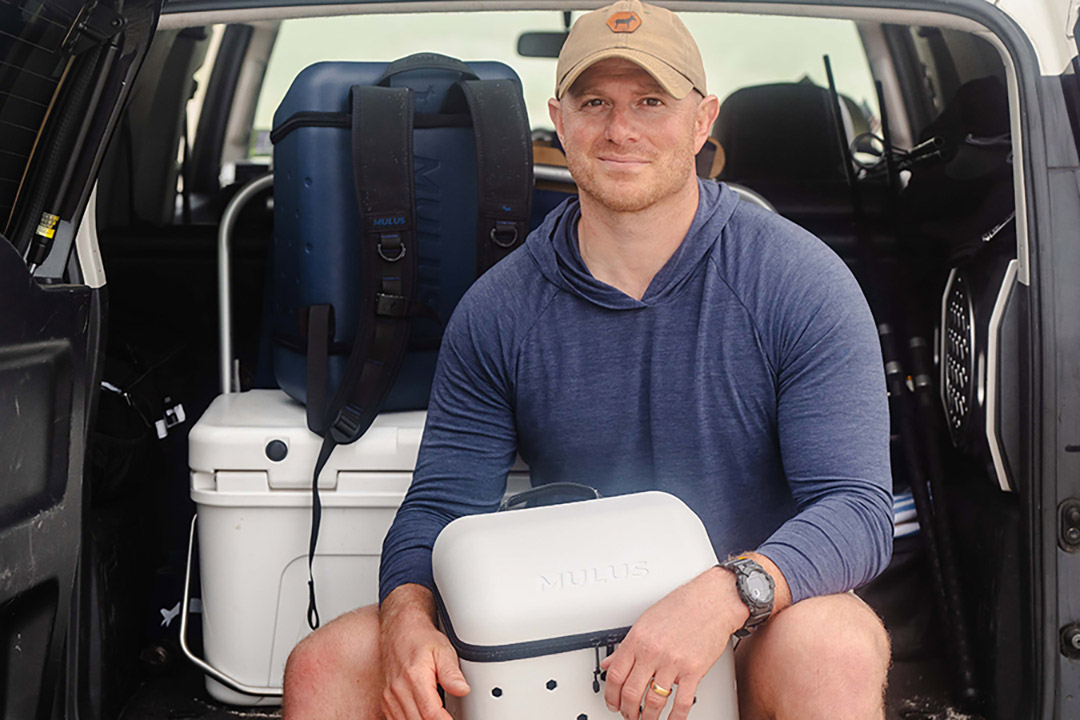
Loading...


